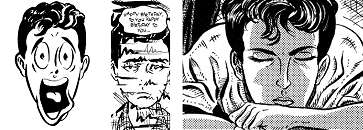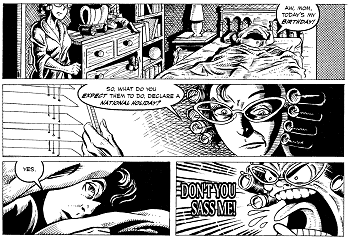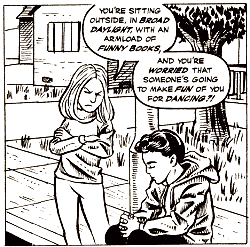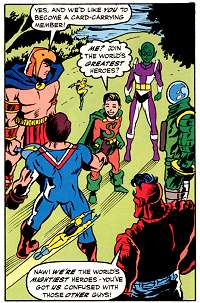A Touch of Silver

 Nostalgia is big these days. Not just the fashion czars’ dictates of bellbottoms and sideburns, but especially in the realm of comics. It’s only natural in these uncertain times to look back at the good old days. That’s what Jim Valentino has done with A Touch of Silver. But he’s cheating; he’s showing us that things weren’t that simple, even for a 9-year-old in the Silver Age.
Nostalgia is big these days. Not just the fashion czars’ dictates of bellbottoms and sideburns, but especially in the realm of comics. It’s only natural in these uncertain times to look back at the good old days. That’s what Jim Valentino has done with A Touch of Silver. But he’s cheating; he’s showing us that things weren’t that simple, even for a 9-year-old in the Silver Age.
A Touch of Silver is the story of Timmy Silver, a child living in the innocent times of the early 1960’s, when the Marvel Age was dawning, before Camelot was being built on Pennsylvania Avenue, and before the Beatles’ long hair corrupted the youth of America. But Timmy’s life - like most of the actual reality behind the nostalgia - isn’t idyllic. It is instead a rollercoaster of joy, despair, hope, disappointment, and confusion. His family is what we would now call “highly dysfunctional”, with a mother who ranges from harpy to protective, a father who is both abusive and needy, and a sister who is as turns snotty and withdrawn. Timmy himself is no less complex.
 Valentino’s art reflects this ambiguity and changeability. It’s primarily a kind of classic non-superhero, non-humor cartoon: realistic forms simplified and stylised for easy rendering and reading in line art. But depending on the mood of the scene - or even a single panel - it can veer off into wild Tex-Avery exaggeration, moody art-school realism, or harsh edgy abstraction. While this sort of variation in art styles is common in Japanese comics, it’s a little surprising in American comics, but it’s used to good effect. You can get a sense of how inhuman his parents seems when they loose control, the gravity of Timmy’s bedroom musings, or the unreality of being reprimanded by the teacher in front of the whole class.
Valentino’s art reflects this ambiguity and changeability. It’s primarily a kind of classic non-superhero, non-humor cartoon: realistic forms simplified and stylised for easy rendering and reading in line art. But depending on the mood of the scene - or even a single panel - it can veer off into wild Tex-Avery exaggeration, moody art-school realism, or harsh edgy abstraction. While this sort of variation in art styles is common in Japanese comics, it’s a little surprising in American comics, but it’s used to good effect. You can get a sense of how inhuman his parents seems when they loose control, the gravity of Timmy’s bedroom musings, or the unreality of being reprimanded by the teacher in front of the whole class.
 Although Timmy is the protagonist - he’s the only character whose head we really get inside of - he’s certainly not the hero in the Silver Age sense. His reaction to a schoolyard bully is not admirable… just very understandable. By the same token, his antagonists are not “villains”. The same father who abuses and belittles Timmy and whose infidelity causes huge problems for the whole family, clearly loves the boy and regrets - or at least questions - his mistakes. The same mother who continually nags, scolds, and criticises Timmy, fights vehemently for him.
Although Timmy is the protagonist - he’s the only character whose head we really get inside of - he’s certainly not the hero in the Silver Age sense. His reaction to a schoolyard bully is not admirable… just very understandable. By the same token, his antagonists are not “villains”. The same father who abuses and belittles Timmy and whose infidelity causes huge problems for the whole family, clearly loves the boy and regrets - or at least questions - his mistakes. The same mother who continually nags, scolds, and criticises Timmy, fights vehemently for him.
 Although there’s a ongoing sequence of events and developments that form the framework around which A Touch of Silver is built, it’s told mostly as a series of vignettes, set sometimes months apart. Timmy’s birthday party. His parents’ fights (with each other, and him). His neighbour Debbie teaching him to dance. A fishing trip with his father. Getting into a shoving match on the playground. Timmy’s mother throwing away his comics….
Although there’s a ongoing sequence of events and developments that form the framework around which A Touch of Silver is built, it’s told mostly as a series of vignettes, set sometimes months apart. Timmy’s birthday party. His parents’ fights (with each other, and him). His neighbour Debbie teaching him to dance. A fishing trip with his father. Getting into a shoving match on the playground. Timmy’s mother throwing away his comics….
Yep, although this is far from being a superhero comic, it’s clearly written by and for the fan of superhero comics. Which is OK, because nearly all comics readers today either are or were superhero fans. Valentino uses this as the hook to draw us in, giving us events to which we in particular can relate, even if the generations and life situations don’t quite match up. It works. Despite being some 10 years’ Jimmy’s - I mean “Timmy’s” - junior and growing in a much less hostile home, I can understand how he feels: fascinated by superhero comics, fantasizing about having super powers, the anxiety of losing these posessions, etc. Combined with the equally universal anxieties - and genuine joys - of being a child, I can relate to Timmy on a very visceral level. (And one 15-year-old letter writer clearly managed to bridge the generation gap.)
 Incidentally, Valentino faced a bit of a problem when it came to depicting the 1960’s comics characters that are a part in Timmy’s life. He’d originally planned to use the “real” ones (Superboy, the Avengers, etc.) but discovered that legally he wasn’t allowed to. So, with permission from his friends their creators, he borrowed the “1963″ and “Big Bang” knock-offs/homages of Marvel’s and DC’s heroes, which (conveniently) had previously been published through Valentino’s company (he’s one of the founders of Image). They came in especially handy for a fun “imaginary story” sequence in one issue.
Incidentally, Valentino faced a bit of a problem when it came to depicting the 1960’s comics characters that are a part in Timmy’s life. He’d originally planned to use the “real” ones (Superboy, the Avengers, etc.) but discovered that legally he wasn’t allowed to. So, with permission from his friends their creators, he borrowed the “1963″ and “Big Bang” knock-offs/homages of Marvel’s and DC’s heroes, which (conveniently) had previously been published through Valentino’s company (he’s one of the founders of Image). They came in especially handy for a fun “imaginary story” sequence in one issue.
Yeah, I did say “fun”. Despite the rather heavy, painful, and serious aspects of this story, there’s still a lot of youthful innocence as well. And perhaps that’s part of Valentino’s point. Through his “escapes” into superheroic fantasy, as well as finding the joy in a new bicycle, or a girl consenting to dance with him, or a brief “father-son” connection with his dad, Timmy still finds that touch of a silver lining in the grey clouds of his life.
There are some bits in the series I could quibble with, such as the use of large, but hard-to-read type (instead of more organic hand-lettering) for shouting; Timmy’s sad puppy-dog eyes get a bit maudlin at times; and the inking on the last issue was distractingly lacking in solid blacks. But overall, it was a very good series, deserving of every bit of praise it received from the who’s-who of the industry who wrote in response to the preview copies Valentino sent out. I know sales weren’t all that great, but I look forward to him resuming the series… soon, I hope.
